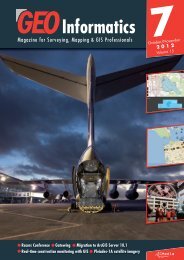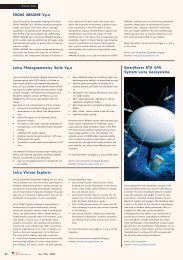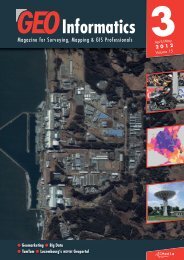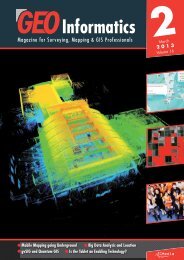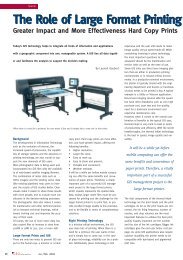2013 - Geoinformatics
2013 - Geoinformatics
2013 - Geoinformatics
Create successful ePaper yourself
Turn your PDF publications into a flip-book with our unique Google optimized e-Paper software.
43<br />
Designing Great Products<br />
Beyond sharing the new capabilities of Esri<br />
software that will be incorporated in imminent<br />
ArcGIS releases, summit presentations focused<br />
on software design that promotes productive<br />
and pleasant user experiences. Interface and<br />
design in general were also the topic of summit<br />
keynote speaker Jared M. Spool. The<br />
founder of the world’s largest usability<br />
research organization, User Interface<br />
Engineering, Spool has spent a lifetime trying<br />
to figure out what makes great designs. He<br />
observed that “the best products are made up<br />
of decisions, lots of decisions,” but his challenge<br />
has been figuring out how design decisions<br />
are made.<br />
Using numerous examples drawn from web<br />
design, Spool showed how designs fall into<br />
one of five styles: unintended, self-design,<br />
genius, activity-focused, and experiencefocused.<br />
Over decades of studying how successful<br />
companies design, Spool has found<br />
that activity-focused and experience-focused<br />
design—neither is based on rules or dogma—<br />
yield far superior results. In design work,<br />
“exception cases far outnumber normal cases.<br />
So you’re always designing for exceptions,”<br />
he said. “You’re always designing for constraints.<br />
You’re always designing for trade-offs.<br />
So this is key.”<br />
Keynote speaker Jared Spool, founder of the world’s largest usability<br />
research organization, discussed how design decisions are made.<br />
The Elegant and Evaporating Interface<br />
In a subsequent presentation, Amber Case,<br />
former CEO of the recently acquired Geoloqi<br />
and now head of the Esri R&D Center in<br />
Portland, Oregon, approached interface<br />
design from another angle. A cyborg anthropologist,<br />
she is deeply interested in the interaction<br />
of humans and computers. She took the<br />
plenary stage to discuss the intersection of<br />
location and the future of interface development.<br />
Case noted that tools have moved from being<br />
extensions of our physical selves (for example,<br />
a knife being a better version of a tooth)<br />
to extensions of our mental selves. However,<br />
unlike physical tools that retain the same size<br />
and function, mental tools are much less constrained<br />
and are changing form and function<br />
rapidly.<br />
For some applications, with the addition of<br />
location, buttons disappear entirely and the<br />
user becomes the button. Interaction with these<br />
applications is less intrusive because the user’s<br />
location is the input that causes certain actions<br />
based on the locational context that anticipates<br />
the user’s needs and wants.<br />
In closing, Case urged developers to use location.<br />
“I’d encourage all of you to think a little<br />
bit wider—how you can solve real-world problems<br />
by adding locations and how you can<br />
actually bring more of what was formally stuck<br />
on the web as static content to life [by] assigning<br />
location to it and delivering it to where it<br />
actually is, where people actually are.”<br />
Learning, Working, Playing<br />
This year’s DevSummit featured additional,<br />
shorter, and more focused technical sessions<br />
that described how to work most effectively<br />
with Esri development tools in incorporating<br />
location into applications. Even shorter and<br />
less formal tech-transfer events occupied the<br />
late afternoon and evening hours. Speed<br />
geeking, introduced last year, was a roundrobin<br />
of five-minute sessions presented on the<br />
first evening by Esri staff on aspects of the technology<br />
to constantly changing groups of 8–10<br />
attendees. At Lightning Talks, attendees got<br />
quick bites of knowledge on a range of topics.<br />
Mingling poolside with Esri developers at<br />
the Meet the Team event, attendees chatted<br />
In addition to killer dodgeball, Dev Summit attendees could<br />
play a giant game of Jenga.<br />
with team members about technology interests<br />
in a relaxed setting.<br />
Developers also had opportunities to highlight<br />
their accomplishments and skills. User presentations,<br />
voted on by the community, were interspersed<br />
with tech sessions throughout the summit.<br />
Developers could also show off their<br />
coding prowess by participating in two<br />
hackathons associated with the summit.<br />
On March 24 at 1:00 p.m., the clock began<br />
ticking for teams participating in the Esri<br />
DevSummit Hackathon. Gathered in one of<br />
the large meeting rooms on-site, teams used<br />
the new ArcGIS for Developers website; Esri<br />
web and/or mobile APIs; and data from<br />
Riverside County, California, to come up with<br />
innovative, location-based projects during the<br />
24-hour contest. With dinner and snacks provided,<br />
contestants toiled through the night.<br />
Entries were judged on creative use of technology,<br />
user experience, and potential for<br />
real-world application.<br />
The Animal Spotter App—developed by<br />
Christopher Moravec, Mara Stoica, and Ryan<br />
Colburn—won first place and a set of<br />
DevSummit passes. Michael van der Veeken<br />
and Paul Kaiser won second place, and<br />
Christoph Sporri, Andry Joos, and Michael<br />
Faulcon earned third place.<br />
For the other hackathon, the100 Lines or Less<br />
ArcGIS JavaScript Code Challenge (ArcGIS.js<br />





